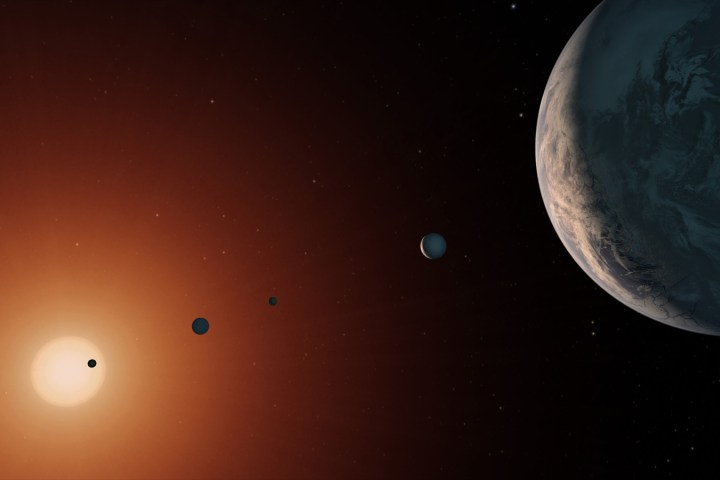
The scientific breakthroughs and discoveries of 2017 were ones for the history books. Exoplanets, indestructible animals, unpredictably intelligent machines — there was something for everyone. But not all of the news was so uplifting. Some of the most important findings, like those linked to climate change, were hard to swallow.
From recycled rockets to climactic wake up calls, here are some of the most exciting science stories of 2017.
CRISPR Edits Human Embryo

No year-end list would be complete without a nod to CRISPR, the genetic wonder tool that is already revolutionizing science and medicine. For years CRISPR has been used to edit genomes with little fuss, but 2017 saw the first case in the United States of CRISPR being used to edit a human embryo. And it did so in a remarkable way.
The project involved editing the human genome to fix a genetic defect that can cause severe heart problems. Similar research had been conducted in China, but at the cost of inviable embryos. Legal and regulatory obstacles remain in CRISPR’s future (not to mention the oft-cited ethical qualms of editing human embryos) but studies like these give evidence for it’s potential.
Lambs are Kept Alive in Baby Biobags

And the award for the most oddly adorable biotech story of the year goes to: lamb biobags. Conducted by physicians at the Children’s Hospital of Philadelphia, the research saw premature lambs placed into fluid-filled plastic bags designed to mimic the environment of the womb. The results showed that these “critically premature” babies could be kept alive for up to six weeks. Moving forward the researchers hope to conduct preclinical animal trials before potentially using the biobags for human babies.
Bionic Skin Takes Us One Step Closer to Cyborgism
We know, we know — 3D printing is so 2015. Or what it 2016? Either way, this past year saw a handful of 3D printing breakthroughs that make it well worth a revisit. Not least of these was a prototype of a 3D bioprinter capable of mass-producing human skin. In the short term expect this tech to be limited things like testing new compounds, but in the long term the researchers hope their device could print skin transplants for victims of burn or skin problems. That is, once regulatory agencies give the go-ahead.
SpaceX Rocket Re-launch
To say SpaceX had an exciting year would be a huge understatement. On the heels of a successful but less than stellar 2016, which saw its fair share of explosions, Musk and co entered 2017 with their heads held high. And in March, SpaceX completed a re-launch and re-landing of a recycled rocket, marking the first successful re-flight of an orbital class rocket.
Huge Haul of Habitable Exoplanets
When NASA told the world it had exciting exoplanet news to announce in February, few would have guessed that the agency had discovered not one but three potentially habitable exoplanets in a nearby solar system. Discovered around an ultra-cool dwarf star called TRAPPIST-1, the three habitable-zone planets were announced alongside four more exoplanets just outside of the star’s habitable zone. NASA also agency released a 360-degree virtual reality look at what it might be like to stand on the surface of one of those planets.
Neutron Stars Shake Space-Time

This was, without a doubt, the most space-time rippling discovery of the year. Albert Einstein’s long sought after gravitational waves were first confirmed in 2016, but it wasn’t until August of this year that researchers confirmed the collision of two distant neutron stars, which created a massive explosion that literally shook the fabric of space and time. The event made gravitational waves the most talked about scientific topic, and was called the scientific breakthrough of the year by the journal Science.
AlphaGo is Back and Better Than Ever

It took just four games for a machine to challenge what we thought we knew about artificial intelligence. When Google’s program AlphaGo defeated a top Go player last year, even AI experts were stunned. They thought it would take AI at least another decade to achieve such a feat.
But this October, a few months after AlphaGo “retired,” DeepMind revealed that its newer, shinier, and smarter program, AlphaGo Zero, had been trouncing players without their knowledge. Amazingly, AlphaGo Zero managed to learn Go from scratch, knowing nothing but the rules and creating its own knowledge along the way. After just three days of self-playing, Zero was able to beat its predecessor 100 games to none.
Another Climate Change Wakeup Call
Let’s face it — climate change is exciting, just not in a good way. More of an anxiety-inducing kind of way. We’re fascinated and frightened by its power to destroy. There were a lot of important climate science findings this year, but perhaps the most illuminating was a review by NASA and the National Oceanic and Atmospheric Administration (NOAA), which found that 2016 was the warmest year globally since records were first kept in 1880. The facts are in. Climate change is not a Chinese hoax. It’s an inconvenient truth in an age of fake news.
An Indestructible Animal

You know who else doesn’t care about climate change? Tardigrades. Not because they’re in denial but because they’re practically indestructible. Thanks to researchers from Harvard and Oxford, tardigrades, aka “water bears,” aka “moss piglets” are the ultimate survivors. Come hell or high water, these little guys may be Earth’s last living creatures. At least until the Sun swallows our planet in 10 billion years or so.
Editors' Recommendations
- Watch SpaceX practice an emergency escape from its Crew Dragon capsule
- SpaceX Dragon spacecraft completes final mission ahead of crewed launch
- Another SpaceX Starship prototype destroyed during pressure test
- Problem in parachute test forced SpaceX to drop its mock spacecraft
- NASA asks for the public’s help to design a robot for digging on the moon



